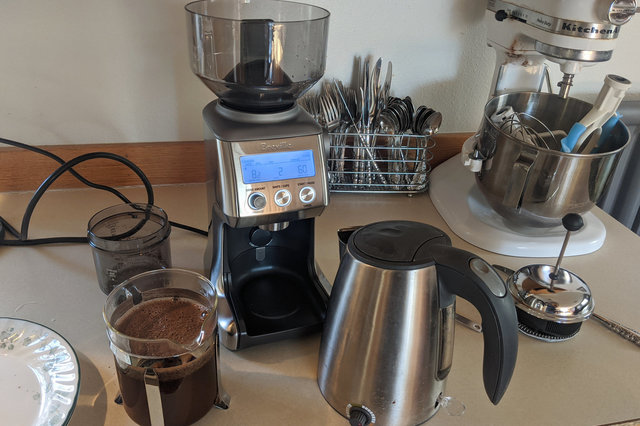Coffee From Home
Started: 2020-05-10 21:25:47
Submitted: 2020-05-10 23:43:18
Visibility: World-readable
In which the intrepid narrator upgrades his home coffee equipment in (gestures vaguely at everything) the current crisis
In the pre-Coronavirus times, most of the coffee I drank came from my employer. Most Google microkitchens have espresso machines, and most buildings have espresso bars where staff baristas will make coffee for free. (I like to say, and it's not a joke, that I learned to make espresso during new-employee orientation week, via a sticker attached to the espresso machine that pointed me to the how-to guide. I still can't make latte art, though.) I discovered pour-over coffee at the third-floor coffee bar in the San Francisco office, a short walk from my desk. The Seattle offices have a robot that will make pour-over coffee at the touch of a button, programmed with the right spiral pattern with the right delays to maximize the extraction of the coffee.
Then COVID-19 shut down my office for the foreseeable future* so I had to make my own coffee.
My first step was to get a good supply of coffee beans. Local coffee shop Seattle Coffee Works ramped up its roasting operation and scaled up their coffee-by-mail business. They roast three days a week, and if I get my order in by Sunday evening they roast Monday morning and I have fresh coffee in my mailbox by Tuesday afternoon. I tend to go through a bag of coffee a week, and I order two bags at a time so I don't run out.
(Also, it turns out, the strap that closes the coffee bag can be effectively reused as a nose piece in home-made masks. Of course I didn't figure this out until almost two months into the pandemic, at which point I'd already thrown out a half-dozen coffee bags.)
[* This week we learned that some people might start going back into the office in June, if they're allowed to by local authorities and there's a good reason for them to do so, but maybe some will stay working remotely until the end of the year. Maybe.]
I have a French press and a hand grinder (the picture above comes from Qualcomm almost five years ago; that particular press broke but I replaced it with an identical one a year or two ago), but after a couple of weeks of coffee from home I wanted more variety so I bought a Hario V60 pour-over funnel and a Bonavita electric kettle with a gooseneck (to make it easy to carefully pour the right amount of water to make coffee) and a fancy digital display (so I can heat the water precisely to 95°C, and I could hold the water at high temperature if I wanted). I still drink my French press with breakfast in the morning, then switch to the pour-over for my second cup.
Then I discovered that my hand-crank grinder isn't grinding the coffee beans as finely as is recommended for pour-over coffee. I can adjust the grinder, but adjusting it is kind of fiddly, and then (theoretically) I'd have to adjust it back and forth every time I wanted to switch between French press (which wants a course grind) and pour-over (which wants a grind closer to traditional drip coffee). I looked for a good adjustable grinder and decided I liked the Breville Smart Grinder Pro, a fancy grinder with a digital display telling me more than I need to know about the grind. I ordered it one night to reward myself for applying to more jobs (in my attempt to install myself in the Bay Area this summer to avoid another winter in Seattle, a plan that seems somewhat more suspect given (gestures vaguely at everything) the current situation), and it arrived this week.
I've only had a couple of days with my new coffee grinder (and I haven't yet figured out how to fit it on the kitchen counter) but so far I like it. (And if I ever break down and get an espresso machine I can use this grinder for that too.)
Other than coffee life in COVID-19 has stabilized. We hit quarantine fatigue this week and sent Calvin and Julian to stay with their cousin in Bellingham for the weekend; both of our households had been carefully distanced for the better part of two months so the additional risk of commingling our households seemed manageable (to the extent that we can really understand what the risks are). This meant we had the house to ourselves for forty-eight hours, which was nice.
I still want to know what comes next, and I'm still worried that the country is reopening too fast and too slow (at the same time). In Washington cases and deaths seem to have stabilized, so when I run the curve fit to extend the current trend to estimate when cases and deaths will drop below some threshold the answer I get is "never". It's still not clear whether I'll be able to find a job in the Bay Area, but at least I have some credible leads, though now I'm not sure how to evaluate them. I want to have a plan even if the schedule slips because I can work with that. It's all the uncertainty that I'm still struggling with.




